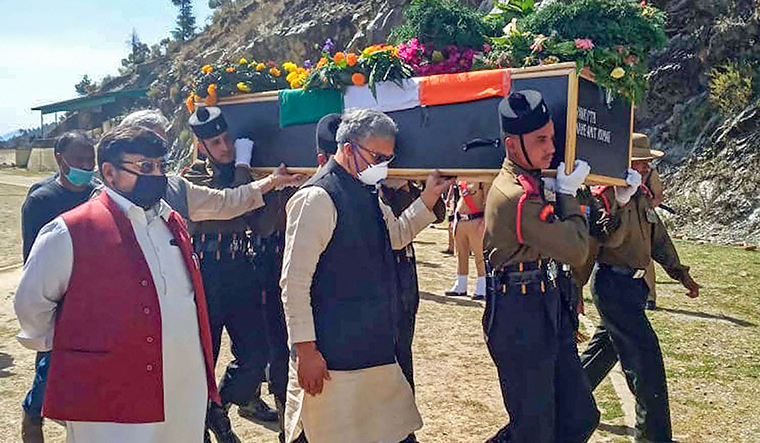A river runs through Keran village, so does the Line of Control (LoC). What Pakistan calls daryayi (river) Neelum becomes the Kishanganga in India. The village, however, has the same name on both sides of the border. In other areas along the LoC, the Kishanganga separates Pakistan-occupied-Kashmir (PoK) from Jammu and Kashmir; in Keran, the river is fully in PoK. Hence, since the 1990s, Keran has been one of the preferred entry points into Kashmir for militants. Usually, they cross the river and scale the Shamshabari mountain range to sneak in.
On April 1, five heavily armed militants entered Keran in north Kashmir’s Kupwara district. The Army, however, trapped them in a gorge between the LoC and the mountains. The five-day-long Operation Rangdori Behak ended with the killing of the militants. The Army lost five men of 4 Para (Special Forces)—Subedar Sanjeev Kumar, Havildar Davendra Singh, Paratrooper Bal Krishan, Paratrooper Amit Kumar and Paratrooper Chhatrapal Singh. The last four hours of the operation saw close-quarters combat so intense that the bodies of the fallen soldiers and the infiltrators lay only a few feet apart. The Army recovered five AK-47 rifles, two under-barrel grenade launchers, two pistols, ammunition, satellite radio, medicines including morphine and dry rations including figs, cashew nuts and Tang drink mix.
While the Army has a network of sensors, thermal imagers and long-range observation radars along the LoC, sources said the inclement weather and mountainous terrain helped the militants this time. Heavy snowfall often damaged fences, they said.
Chinar Corps Commander Lt Gen B.S. Raju said that soon after the militants slipped in on April 1, the platoon guarding the area gave chase and cornered them at 1pm. He said that the militants then ditched much of their gear and hid in a gorge. By evening, the Army had trapped them between the LoC and the mountains. “For the next two days, the Army used helicopters and unmanned aerial vehicles for better situational awareness, and further isolated the group,” he said. On April 4 noon, a group of Special Forces personnel was airdropped near the militants’ hideout. “As the Special Forces were approaching the target area, one of the terrorists, probably a guide, started to run towards the LoC and was neutralised by the Army,” said Raju. “(The soldiers) approached the target area traversing extremely challenging terrain in high snow and over extremely steep slopes.” By late evening, a gun battle ensued, and in the next five hours, the militants were neutralised. “When the world is fighting the Covid-19 pandemic, Pakistan is aiding and abetting infiltration,” said Raju. “I would like to tell you that we are here at the LoC and we will not tolerate any mischief from Pakistan.”
A video released by the Army on April 10 showed it targeting Pakistan army’s gun positions, terrorist launch pads and an ammunition dump in PoK. The Army spokesman in Srinagar, Col Rajesh Kalia, confirmed in a statement that the Army had retaliated to the ceasefire violations by Pakistan and inflicted heavy damage. Sources said the Army targeted the Pakistani positions with medium and heavy artillery. On April 12, three civilians were killed in artillery shelling by Pakistan in Kupwara.
The April 1 infiltration attempt was the second such bid by militants to ferry weapons from PoK to Kashmir through Keran since the abrogation of Article 370 on August 5, 2019. This March, the police reportedly recovered a huge cache of arms from Keran after arresting a militant module at Sopore in Baramulla. On interrogation, the militants allegedly revealed that the weapons were meant for the newly formed The Resistance Front (TRF), linked to the Lashkar-e-Taiba. Security officials said that the TRF was formed to provide cover to the activities of the LeT, after the Financial Action Task Force (FATF) threatened to blacklist Pakistan over its support to militants.
Though the Army did not reveal the identity of the militants killed in Keran, a family from south Kashmir’s Shopian district identified one of them as Sajjad Ahmad Hurra, who was missing since 2018. Sajjad’s family said that they recognised him from the pictures of slain militants shared on social media. His father, Mushtaq Hurra, told THE WEEK that Sajjad and his friend Adil Bashir Wani left Kashmir to work in Saudi Arabia in April 2018. He said that after a few days, the nambardar (village headman) told him that the Army was enquiring about the whereabouts of the boys. “The next day when Sajjad called, I told him that the Army was looking for them and not to switch off the phone,” he said. “But Sajjad called again the next day to say that they would be switching off their phones as they were at a hospital to get some tests done before flying to Saudi Arabia.” That was the last he heard from his son, said Hurra. Sources said Sajjad and Adil travelled to Pakistan via the Wagah border.
After reports of Sajjad being one of the slain militants spread, the police raided his house and arrested his brother. Hurra and Adil’s family have approached the deputy commissioner of police, Kupwara, for a DNA test to verify whether their sons were among those killed in Keran. The family of Sartaj Ahmed from Kulgam, too, has requested the same. Sartaj went missing in December 2017. Hurra said that Kupwara’s senior superintendent of police has been directed to collect DNA samples.
The Keran incident has reinforced fears about increased violence in Kashmir, triggered by the revocation of Article 370. With the FATF extending Pakistan’s deadline from April to October to comply with its requirements to get off the grey list, the militants, it seems, are using the diversion caused by the pandemic to cross the border.



